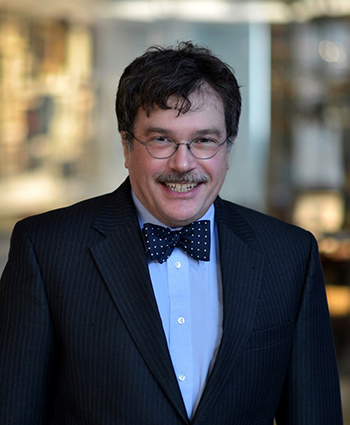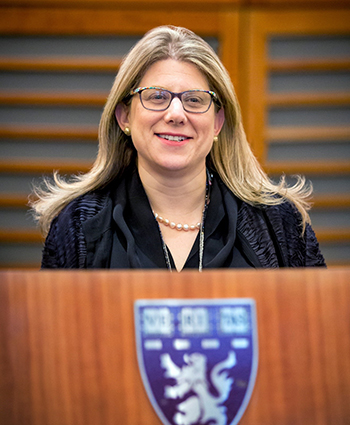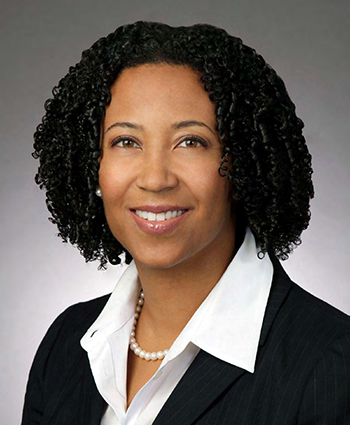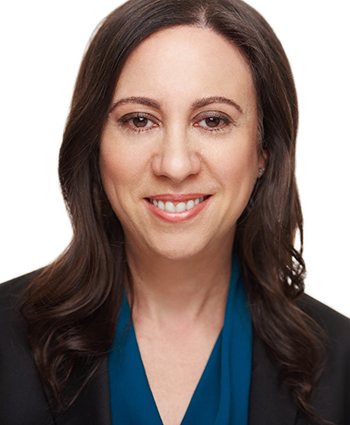For most aspiring physicians, the path is straightforward: go to medical school, then residency, then enter clinical practice. While that chain of events suits many doctors, some physicians are pursuing opportunities outside the scope of traditional medicine after they’ve completed their training.
“People are recognizing that there's some value to having clinicians, whether they're physicians or nurses or physical therapists, involved in some of the things that decide the course of organized medicine,” says AAMC Executive Vice President Atul Grover, MD, PhD. “Whether that's the business of medicine, public policy, or consulting, all those things benefit from having people with clinical backgrounds.”
Universities and their academic health centers are taking note, with a growing number of dual-degree programs that allow students to get their MD while simultaneously working toward a JD, PhD, MBA, MPH, or other advanced degree. Students who opt for concurrent education can often finish their training in less time than it would take to pursue an MD and another program separately and get a head-start on their careers.
“You can make medicine whatever you want it to be,” says Grover.
Here’s a look at several physicians who combined their medical training with education in complementary fields, and how students interested in similar career pathways can follow their passions.
Peter Hotez, MD, PhD
Ever since he was 12 years old, Peter Hotez, MD, PhD, has wanted to study tropical diseases. Now as dean of the National School of Tropical Medicine at Baylor College of Medicine in Houston, Texas, and co-director of the Texas Children’s Hospital Center for Vaccine Development, his childhood ambitions have been realized.
Hotez’s path to becoming a physician-scientist began with a combined MD-PhD program through Rockefeller University and Weill Cornell Medical College. During his training, Hotez conducted research that would lead to the development of a vaccine for hookworm infection. His PhD education gave him the foundation to develop vaccines, and pursuing an MD helped him understand medicine and translational research more broadly, he says.

While serving as chair of the department of microbiology, immunology, and tropical medicine at The George Washington University School of Medicine and Health Sciences, Hotez became involved in the newly launched United Nations Millennium Development Goals — specifically the sixth goal to “combat AIDS, malaria, and other diseases.” Hotez’s interest was on the “other diseases” that didn’t necessarily get much attention, and so he and colleagues in the field came together to support increased funding and research around tropical diseases.
“That opened a new chapter in my life, where on the one hand, I was a physician-scientist-laboratory investigator, but then on the other, having this foot firmly planted in public engagement and social activism, and I found both activities very exciting,” he says.
Hotez’s scientific advocacy has led him to unconventional opportunities within and outside the lab. He was appointed as a U.S. Science Envoy for the Middle East under the Obama administration, exploring conflict and the dearth of vaccine development in the region.
Hotez is also a leading voice against misinformation in health and uses his expertise to fight bad science. His book Vaccines Did Not Cause Rachel's Autism: My Journey as a Vaccine Scientist, Pediatrician, and Autism Dad, intertwines his personal experience with evidence debunking links between autism and vaccines.
Hotez believes that physician-scientists can have an influential role in promoting the greater good. “There is a unique training given to physician scientists and now I'm trying to look at how we could turn that towards the betterment of humankind,” he says.
What to know about the MD-PhD route: The MD-PhD joint degree is an especially popular pathway, as it offers a straightforward route to becoming a physician-scientist. “Physician-scientists with both MD and PhD degrees are ideally situated to understand both the clinical needs and opportunities, and the laboratory tools that can be brought to bear to understand disease processes and therapeutic strategies,” says Ross McKinney, MD, AAMC Chief Scientific Officer. According to AAMC data, nearly 80% of MD-PhD program graduates have career paths consistent with physician-scientist training, with more than three-quarters of graduates conducting research. Those findings align with the career trajectories for students at the University at Buffalo’s (UB) MD-PhD program, where students come in with a clear passion for research, says program director Suzanne Laychock, PhD. Fewer than 30 students each year are admitted to the rigorous program. Over the course of seven to eight years, students typically spend four years in the Jacobs School of Medicine and Biomedical Sciences and three years in the graduate school at UB. Laychock, who is also senior associate dean for faculty affairs and facilities, notes that about 65% of graduates who complete their residencies hold faculty positions in academic medicine.
Rebecca Brendel, MD, JD
As someone who grew up in a family of physicians and health care professionals, Rebecca Brendel was instilled with the belief that it is a privilege to help others. She still takes that creed to heart, although her work now largely involves guiding medical students and colleagues in navigating complex ethical challenges, from end-of-life issues to caring for patients with impaired decision-making ability.
Brendel is the director of the master’s degree program at the Harvard Medical School Center for Bioethics and director of law and ethics at the Center for Law, Brain, and Behavior at Massachusetts General Hospital (MGH). Brendel is also an associate professor of psychiatry at Harvard Medical School and a psychiatrist at MGH.

“Anybody who's engaged in any practice of medicine today really is already engaged in the world of bioethics, whether or not they're acutely aware of it,” says Brendel. “We make ethical decisions or decisions with ethical implications on a daily basis and face really tremendous challenges as well in the course of treating patients.”
Brendel didn’t know from the beginning that she would go into bioethics. Seeking a strong liberal arts education, Brendel studied philosophy as an undergraduate student at Yale University. She then went on to get a law degree from the University of Chicago (UChicago) School of Law and a medical degree from the Pritzker School of Medicine in a joint-degree program.
Brendel took on several professional development opportunities before completing her education in medicine and law. She took part in an ethics fellowship at UChicago’s MacLean Center for Clinical Medical Ethics and chaired a human rights committee at a mental health facility. By the time she got to residency, Brendel had enough experience to sit on the ethics committee of MGH.
Brendel says that while it may look like her career trajectory easily fell into place, there is more than meets the eye.
“Something that I always try to impart to others is this idea that you don’t have to have the path completely set from the beginning,” says Brendel. “Sometimes being too planned out doesn't allow you to explore or recognize things that might be great opportunities.”
What to know about the MD-JD route: With an MD and JD, graduates of dual-degree programs may choose to go into medical ethics, but they may also consider going into health care law or providing legal counsel for a hospital or health care system. At the University of Miami’s MD-JD degree program, led by the Miller School of Medicine and the School of Law, for instance, students apply to the law school during their second year of the MD program, allowing them to focus on legal education for years three and four before completing the MD and JD requirements. Sandra Abraham, executive liaison of interdisciplinary programs and initiatives for the School of Law, notes that students can participate in a range of cross-disciplinary activities. One option is the Health Rights Clinic, a collaboration through the schools of medicine and law with representation focused on social security and public benefits, advanced directives, immigration, and veterans’ benefits.
Dora Hughes, MD, MPH
Medicine was always the career path for Dora Hughes, MD, MPH. But an experience during her second year of residency at Brigham and Women’s Hospital shifted her perspective on health care. Hughes went from caregiver to patient when she was diagnosed with multiple sclerosis, spurring her interest in the social determinants of health.

“It really does open your eyes to a lot of other issues that impact care beyond the actual clinical interventions,” says Hughes, now associate research professor of health policy and management at The George Washington University Milken School of Public Health.
Following residency, Hughes delved into research in access and disparities in care among historically marginalized patient populations and then pursued a master’s in public health from the Harvard T.H. Chan School of Public Health.
“Much of what happens outside of the walls of hospitals and doctors’ offices has a tremendous impact on patient health and going through the program and attending the school of public health helped me to understand all of that in a very rigorous way,” says Hughes.
After receiving her MPH, Hughes served as a senior program officer at the Commonwealth Fund, which promotes accessible and affordable health care. She then took her health policy expertise to the federal government, where she would have a role in shaping the Affordable Care Act.
Hughes was deputy director for the HELP Committee under Sen. Edward M. Kennedy and then health policy advisor to then-Sen. Barack Obama. She continued to make her mark on federal health policy as counselor for science and public health to former Secretary Kathleen Sebelius at the U.S. Department of Health and Human Services.
She encourages physicians who are interested in public health and health policy to explore opportunities in state and local health departments, think tanks, and even Capitol Hill.
“As a physician, you're always able to contribute to health policy discussions,” says Hughes. “You understand not just the clinical aspects, but you understand the patient, you understand the barriers to care, you understand the opportunities to intervene, you understand the priorities, if you really want to influence health.”
What to know about the MD-MPH route: For students interested in how social determinants of health affect access to and quality of care, the MD-MPH dual degree is a natural fit, says M. Moe Bell, MD, MPH, director of the MD-MPH Dual-Degree Program through the University of Arizona College of Medicine and the Mel and Enid Zuckerman Arizona College of Public Health. Students take core MPH courses in subjects including epidemiology, biostatistics, and health policy and management during their five-year program. With their education, they may opt to work in public health at the local level at a state health department or address public health on a larger scale, such as at the Centers for Disease Control and Prevention or the United States Public Health Service Commissioned Corps, responding to national health priorities.
Jennifer Meller, MD, MBA
Even though Jennifer Meller was doing well as a physician with a private practice in New York City, she craved a new challenge. Tapping into her “entrepreneurial spirit,” Meller enrolled in the Wharton School of the University of Pennsylvania to obtain a master’s in business administration.

“I saw medicine changing around me and a whole landscape changing, and I wasn't sure I'd be able to continue doing what I'm doing in the way I was doing it,” Meller says. “I also saw digital health start to explode.”
While in business school, Meller was inspired to tackle a problem that irks health care providers and patients alike: the uncertainty of wait times to see a clinician. Her idea took shape one day while ordering a ride through a car share service. If she could get a ride through an app, she thought, why couldn’t the same technology be applied to streamlining the waiting room experience? She founded and is the CEO of Navimize, a digital platform that updates patients with real-time communication and helps providers reschedule appointments.
Meller still regularly sees patients and says that she has “the best of both worlds” as a doctor and an entrepreneur working in the booming field of health technology. “It really makes me feel good and keeps me going every day that I'm working on a technology that is beneficial to patients and beneficial to physicians,” she says.
While Meller has been invigorated by the startup space, she encourages aspiring physician-entrepreneurs to focus on clinical skills first.
“Don't rush to be the entrepreneur before you give yourself a chance to learn what it's like to be a doctor,” she says.
What to know about the MD-MBA route: While being an entrepreneur is one exciting pathway, physicians-in-training have plenty of career options with an MD and an MBA. Michael Waldhier, MBA, director of admissions at Pennsylvania State University’s Smeal College of Business, notes that many of the students who go into the school’s MD-MBA program are interested in learning skills that will help them run successful clinical practices or lead hospital administration. Students in the five-year program begin with three years immersed in the College of Medicine, then tackle their MBA coursework the fourth year, and wrap up their training with MD and MBA education and clinical rotations in year five.
